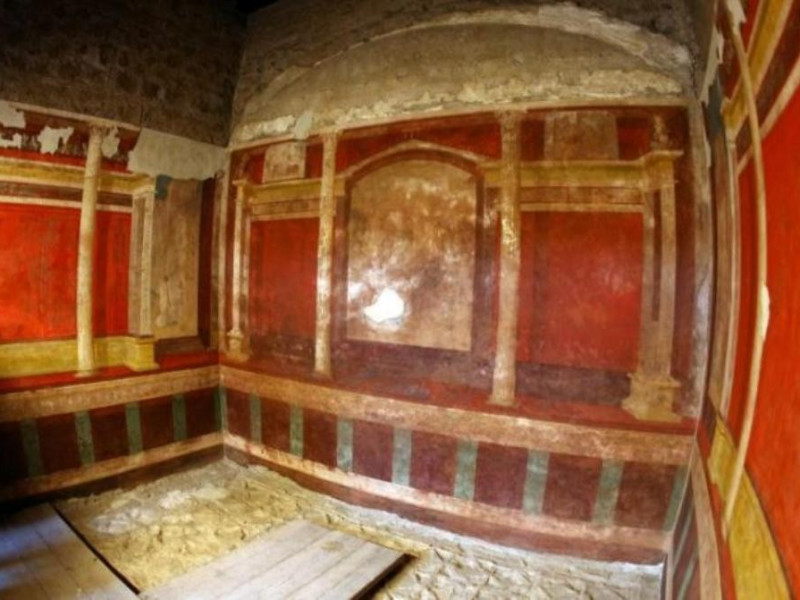Luogo - Archaeological Area
Parco archeologico del Colosseo - Casa di Augusto
Where
Piazza di S .Maria Nova, 53, Roma
ctavian was born on the Palatine in 63 b.C. and many years before being named “Augustus” he decided to have his residence on the same hill; his successors followed his choice and the Palatine became the seat of Imperial residence until the late Roman Empire. With a genius political move Octavian purchased the house of the orator Quintus Hortensius Hortalus, located beside Romulus’ huts and near the Lupercal: a highly simbolic place, closely connected to the origins of Rome. He enlarged the house linking it to other residential buildings of the area, thus creating a vast property which contained both the private house and the temple of Apollo Atiacus, following an architecural scheme created and developed in the hellenistic palaces .
The house, which underwent various and complex structural changes until the years of the Flavian Emperors, had a private and a public side, the latter closely connected to Apollo’s Temple; both of them are decorated with refined paintings and balck and white mosaic floors.
In the private sector it is possible to admire the “room of pine garlands” , which recalls a room of the adjoining Livia’s house, and the “room of the masks”with a rich architectural decoration inspired by theatre scenes, both of them with floors in black and white mosaics.
The public part of the house originally opened on a porticoed perystile and its paintings show an even greater formal care: from the spacious sitting room (oecus) to the bedroom in the ground floor, from the ramp that led to the temple up to the “Studiolo” (small study) at the first floor, the visitor will be able to appreciate some of the most refined examples of roman painting. An extreme refinement, already foreshadowing the style of the Ist century A.D., marks out namely the paintings of the “Studiolo”, a small room at the first floor of the building: the ceiling of the room is decorated with stucco frames alternating with traditional paintings. On the walls, smalls objects and animals such as candlesticks, lotus flowers, swans and griffons are painted on red, yellow and black backgrounds: their accomplishment was probably due to a paniter of egyptian origin arrived in Rome after Augustus conquered the hellenistic kingdom.
The house, which underwent various and complex structural changes until the years of the Flavian Emperors, had a private and a public side, the latter closely connected to Apollo’s Temple; both of them are decorated with refined paintings and balck and white mosaic floors.
In the private sector it is possible to admire the “room of pine garlands” , which recalls a room of the adjoining Livia’s house, and the “room of the masks”with a rich architectural decoration inspired by theatre scenes, both of them with floors in black and white mosaics.
The public part of the house originally opened on a porticoed perystile and its paintings show an even greater formal care: from the spacious sitting room (oecus) to the bedroom in the ground floor, from the ramp that led to the temple up to the “Studiolo” (small study) at the first floor, the visitor will be able to appreciate some of the most refined examples of roman painting. An extreme refinement, already foreshadowing the style of the Ist century A.D., marks out namely the paintings of the “Studiolo”, a small room at the first floor of the building: the ceiling of the room is decorated with stucco frames alternating with traditional paintings. On the walls, smalls objects and animals such as candlesticks, lotus flowers, swans and griffons are painted on red, yellow and black backgrounds: their accomplishment was probably due to a paniter of egyptian origin arrived in Rome after Augustus conquered the hellenistic kingdom.
Opening hours:
Spring-Summer (until October 28th 2018):
- Monday, Wendesday, Friday from 9.00 AM to 18.30 PM
- Sunday: 9.00 AM to 14.00 PM
- Monday, Wendesday, Friday from 9.00 AM to 18.30 PM
- Sunday: 9.00 AM to 14.00 PM
Autumn-Winter (until March 31st 2019):
- Monday, Wendesday, Friday from 9.00 AM to 15.30 PM
- Sunday: 9.00 AM to 13.00 PM
- Monday, Wendesday, Friday from 9.00 AM to 15.30 PM
- Sunday: 9.00 AM to 13.00 PM

